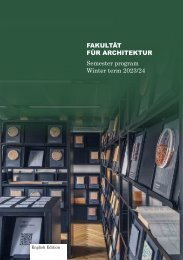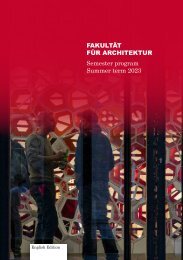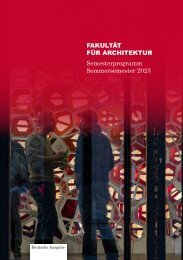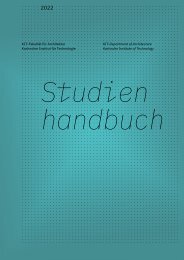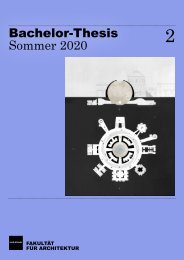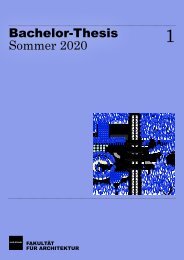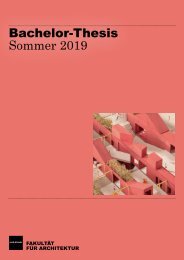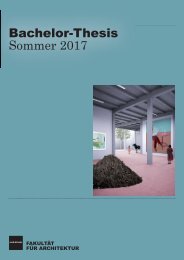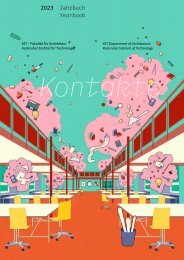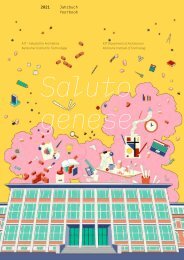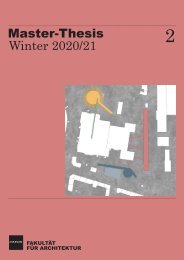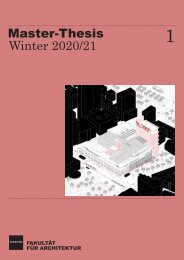- Seite 1 und 2: 2O22 Jahrbuch Yearbook KIT - Fakult
- Seite 3 und 4: 2 Jahrbuch
- Seite 5 und 6: Inhalt Content Vorwort Preface 8 Di
- Seite 7 und 8: Institut Entwerfen von Stadt und La
- Seite 9 und 10: Vorwort Prof. Dirk Hebel Dekan der
- Seite 11 und 12: mit denen wir seit Jahren enge wiss
- Seite 13 und 14: Materials for a new Architectural P
- Seite 15 und 16: lenden Geometrie. Bei beiden bedank
- Seite 17 und 18: . . . . . . . . . . . . . . . . . .
- Seite 19 und 20: BestandTeile Nina Rind Einführung
- Seite 21 und 22: schätzung andererseits werden hier
- Seite 23 und 24: Historische Bestandteile bilden ebe
- Seite 25 und 26: Nina Rind ist akademische Mitarbeit
- Seite 27 und 28: Bestandslücken Manuela Gantner Auf
- Seite 29 und 30: zweiten Reihe am Laufen. Heute wiss
- Seite 31 und 32: sich in diesem Kontext neu. Zwar ha
- Seite 33 und 34: ↘ 1 Dörhöfer, Kerstin (2004): P
- Seite 35 und 36: Annehmen oder ausschlagen? Lukas Gr
- Seite 37 und 38: würde am besten dazu beitragen, di
- Seite 39 und 40: wurden. Im Untergeschoss befinden s
- Seite 41 und 42: »Lebensdauer eines Automobils«
- Seite 43 und 44: den Service eingestellt, aufgrund d
- Seite 45 und 46: ↘ 1 Es gibt verschiedene Auffassu
- Seite 47 und 48: Upscaling / Crafts / of Repairing J
- Seite 49: covered motif, we can speak of an e
- Seite 53 und 54: est advance in domains where things
- Seite 55 und 56: Josep Garriga Tarrés ist wissensch
- Seite 57 und 58: Seminato Philipp Schmider What Can
- Seite 59 und 60: able to deform without compromising
- Seite 61 und 62: the joints enables the new flooring
- Seite 63 und 64: denaturing, making it possible to r
- Seite 65 und 66: Philipp Schmider studiert seit dem
- Seite 67 und 68: Die Lust am Neuen machte vor Nichts
- Seite 69 und 70: ildet sich dann ein Bild und Wissen
- Seite 71 und 72: Namen geben und einer Zeit in der E
- Seite 73 und 74: werden. Was von der denkmalpflegeri
- Seite 75 und 76: setzt, dass die Villa weg muss, and
- Seite 77 und 78: vor diesen alten Techniken - die fe
- Seite 79 und 80: KITbashing Federico Garrido Design
- Seite 81 und 82: Closer to our time, the re-utilizat
- Seite 83 und 84: client specifications. There was of
- Seite 85 und 86: conditions, now under the light of
- Seite 87 und 88: We are interested in Kitbashing and
- Seite 89 und 90: Nicht physische Bestandteile Sophia
- Seite 91 und 92: tueller Realität und bildet damit
- Seite 93 und 94: oten, deren Inhalt sowohl räumlich
- Seite 95 und 96: ↘ 1 Augé (2012), S. 59 ↘ 2 Nov
- Seite 97 und 98: . . . . . . . . . . . . . . . . . .
- Seite 99 und 100: tiny timber tourism (house) Peter H
- Seite 101 und 102:
100 Bildessay
- Seite 103 und 104:
102 Bildessay
- Seite 105 und 106:
104 Bildessay
- Seite 107 und 108:
106 Bildessay
- Seite 109 und 110:
108 Bildessay
- Seite 111 und 112:
110 Bildessay
- Seite 113 und 114:
112 Bildessay
- Seite 115 und 116:
. . . . . . . . . . . . . . . . . .
- Seite 117 und 118:
Aufbau 1 Institut Entwerfen, Kunst
- Seite 119 und 120:
Institut Entwerfen, Kunst und Theor
- Seite 121 und 122:
Erden/Soils Elective Module MA Summ
- Seite 123 und 124:
122 Hartmann
- Seite 125 und 126:
124 Hartmann
- Seite 127 und 128:
126 Hartmann
- Seite 129 und 130:
Institut Entwerfen, Kunst und Theor
- Seite 131 und 132:
Wohnriese 2.0 Master Abschlussarbei
- Seite 133 und 134:
132 Morger
- Seite 135 und 136:
134 Morger
- Seite 137 und 138:
136 Morger C
- Seite 139 und 140:
Institut Entwerfen, Kunst und Theor
- Seite 141 und 142:
STUDIO RAUM Entwurf BA Semester 1 W
- Seite 143 und 144:
142 Frohn A B
- Seite 145 und 146:
VOTE B Fixing DEBATE A A ARCHIVE 0,
- Seite 147 und 148:
146 Frohn I J
- Seite 149 und 150:
Institut Entwerfen, Kunst und Theor
- Seite 151 und 152:
Drawing To Go Floating Images Tell
- Seite 153 und 154:
152 Craig D E
- Seite 155 und 156:
154 Craig I
- Seite 157 und 158:
156 Craig Q R S T U
- Seite 159 und 160:
Institut Entwerfen, Kunst und Theor
- Seite 161 und 162:
Einstürzende Neubauten: Berlin in
- Seite 163 und 164:
Cover Me: Ein neuer Auftritt für d
- Seite 165 und 166:
Nachhaltigkeit Kommunizieren Commun
- Seite 167 und 168:
All Tomorrow's Places: Vortragsreih
- Seite 169 und 170:
Institut Entwerfen, Kunst und Theor
- Seite 171 und 172:
Architecture as Global Governance A
- Seite 173 und 174:
The Investigative Power in Architec
- Seite 175 und 176:
Designing Pedagogy Architecture and
- Seite 177 und 178:
Architecture needs Theory Unter dem
- Seite 179 und 180:
Institut Entwerfen und Bautechnik (
- Seite 181 und 182:
180 Wappner, Vallebuona, Haug
- Seite 183 und 184:
182 Wappner, Vallebuona, Haug
- Seite 185 und 186:
Institut Entwerfen und Bautechnik (
- Seite 187 und 188:
Markthalle - Neue städtische Räum
- Seite 189 und 190:
Münchner Freiheit - Handel im Wand
- Seite 191 und 192:
Off Shore - Transformation der Plat
- Seite 193 und 194:
Institut Entwerfen und Bautechnik (
- Seite 195 und 196:
City Slivers & Fresh Kills - Ein Fi
- Seite 197 und 198:
GimmeShelter! - Ein Tierheim am Kni
- Seite 199 und 200:
Masterarbeiten Master’s Thesis Ma
- Seite 201 und 202:
Institut Entwerfen und Bautechnik (
- Seite 203 und 204:
Ein Haus für EffEff - Zentrum für
- Seite 205 und 206:
Institut Entwerfen und Bautechnik (
- Seite 207 und 208:
Projektentwicklung und Entwurf für
- Seite 209 und 210:
Innovative Wohnformen mit umfassend
- Seite 211 und 212:
LIVING-LAB Barrierefreie und alteng
- Seite 213 und 214:
212 (IEB) L M N O P
- Seite 215 und 216:
Institut Entwerfen und Bautechnik (
- Seite 217 und 218:
Ressource Berlin - Urban Mining am
- Seite 219 und 220:
RoofKIT - Solar Decathlon Europe 21
- Seite 221 und 222:
220 Hebel E F G H
- Seite 223 und 224:
MYCO-FABRICATE - Design and Build w
- Seite 225 und 226:
Institut Entwerfen und Bautechnik (
- Seite 227 und 228:
RoofKIT - Detailplanung Energieund
- Seite 229 und 230:
Solarnutzung Das Dach der Gebäudee
- Seite 231 und 232:
RoofKIT - Detailed Planning of Ener
- Seite 233 und 234:
Solar harvesting The unit's roof is
- Seite 235 und 236:
Institut Entwerfen und Bautechnik (
- Seite 237 und 238:
Massiv Massive Mineralische Baustof
- Seite 239 und 240:
238 Wagner E
- Seite 241 und 242:
Hüllen | Form . Funktion . Konstru
- Seite 243 und 244:
242 Wagner I J
- Seite 245 und 246:
Institut Entwerfen und Bautechnik (
- Seite 247 und 248:
Tragwerksvertiefung des Studio-Entw
- Seite 249 und 250:
248 La Magna A
- Seite 251 und 252:
250 La Magna C D
- Seite 253 und 254:
252 La Magna F
- Seite 255 und 256:
Institut Entwerfen und Bautechnik (
- Seite 257 und 258:
Digital Wicker Im Rahmen des MSc-En
- Seite 259 und 260:
258 Dörstelmann B
- Seite 261 und 262:
Textile Steel Stahl ist ein Werksto
- Seite 263 und 264:
Architekturgeometrie & Digitales Ge
- Seite 265 und 266:
Institut Entwerfen von Stadt und La
- Seite 267 und 268:
Building Bridges re:Generation: New
- Seite 269 und 270:
Leuven Knowledge Factory Einführun
- Seite 271 und 272:
Rauch über den Dächern (1911) - o
- Seite 273 und 274:
Productive Heart - A Future Platfor
- Seite 275 und 276:
Institut Entwerfen von Stadt und La
- Seite 277 und 278:
UrbanLab: Freiburg 2.0 Durch dicht
- Seite 279 und 280:
HUMAN NATURE Natur im Transformatio
- Seite 281 und 282:
Street Resilient Ecologies Upcyclin
- Seite 283 und 284:
Towards Ecocene Mutationen urbaner
- Seite 285 und 286:
Institut Entwerfen von Stadt und La
- Seite 287 und 288:
Postareal Karlsruhe Im ersten Semes
- Seite 289 und 290:
Münchner Norden North of Munich Na
- Seite 291 und 292:
Capriccio Im Wintersemester des fü
- Seite 293 und 294:
Seminare, Stegreife und Masterthese
- Seite 295 und 296:
Institut Entwerfen von Stadt und La
- Seite 297 und 298:
e:GENERATION_ Neue urbane Gemeinsch
- Seite 299 und 300:
Incremental City_ Planen einer kopr
- Seite 301 und 302:
Umschalten! Transformation der Scha
- Seite 303 und 304:
Innercity Desaster In the seminar,
- Seite 305 und 306:
Institut Kunst- und Baugeschichte (
- Seite 307 und 308:
Massive Parallel Documenting - spec
- Seite 309 und 310:
308 Hinterwaldner
- Seite 311 und 312:
Initiative Experimentelle Forschung
- Seite 313 und 314:
Melencolia I & Friends Wie sieht ei
- Seite 315 und 316:
Institut Kunst- und Baugeschichte (
- Seite 317 und 318:
Inventing Nature - Pflanzen in der
- Seite 319 und 320:
Wahrnehmung und Bewertung - empiris
- Seite 321 und 322:
Nachhaltige Vermittlungsstrategien
- Seite 323 und 324:
AISTHESIS. Internationales kunsthis
- Seite 325 und 326:
Institut Kunst- und Baugeschichte (
- Seite 327 und 328:
Architektur, Infrastruktur, Landsch
- Seite 329 und 330:
Seminare als gemeinsame Ausstellung
- Seite 331 und 332:
KITbashing History - Reuse and Reit
- Seite 333 und 334:
Bauen im Bestand_ struktur.ELEMENTE
- Seite 335 und 336:
Gastprofessur der Wüstenrot-Stiftu
- Seite 337 und 338:
Beyond Coexistence, Playing String
- Seite 339 und 340:
Gastprofessur der Sto-Stiftung Gues
- Seite 341 und 342:
Circularity - Architecture as a Mec
- Seite 343 und 344:
saai Archiv für Architektur und In
- Seite 345 und 346:
Saai Archive Talks Egon Eiermann di
- Seite 347 und 348:
346 Data
- Seite 349 und 350:
Fachschaft auf einen Diskurs mit de
- Seite 351 und 352:
ei allen Fragen beratend zur Seite
- Seite 353 und 354:
Personalien PROFESSUREN → Tenure-
- Seite 355 und 356:
354 Data A B
- Seite 357 und 358:
FACULTY TALK #8 ↪ Céline Baumann
- Seite 359 und 360:
↪ 07. Dezember 2021 Hans Rudolf M
- Seite 361 und 362:
sich aus neuen Arbeitsmodellen und
- Seite 363 und 364:
↪ 17. November 2021 SCHELLING ARC
- Seite 365 und 366:
↪ 12. November 2021 Barbara Filse
- Seite 367 und 368:
↪ 15. Februar bis 18. März 2022
- Seite 369 und 370:
AUSZEICHUNG FÜR EHRENAMTLICHES ENG
- Seite 371 und 372:
370 Data D E F
- Seite 373 und 374:
Exkursionen Forschung STADT UND WOH
- Seite 375 und 376:
Promotionen ↪ 22. September 2021
- Seite 377 und 378:
Publikationen Anna Krüger ALEXANDE
- Seite 379 und 380:
378 Jahrbuch
- Seite 381 und 382:
Bildnachweise S. 29 A saai | Südwe
- Seite 383 und 384:
JAHRBUCH DER KIT-FAKULTÄT FÜR ARC




